Anton Ragni
How I Built ASR for Endangered Languages with a Spoken Dictionary
Oct 06, 2025Abstract:Nearly half of the world's languages are endangered. Speech technologies such as Automatic Speech Recognition (ASR) are central to revival efforts, yet most languages remain unsupported because standard pipelines expect utterance-level supervised data. Speech data often exist for endangered languages but rarely match these formats. Manx Gaelic ($\sim$2,200 speakers), for example, has had transcribed speech since 1948, yet remains unsupported by modern systems. In this paper, we explore how little data, and in what form, is needed to build ASR for critically endangered languages. We show that a short-form pronunciation resource is a viable alternative, and that 40 minutes of such data produces usable ASR for Manx ($<$50\% WER). We replicate our approach, applying it to Cornish ($\sim$600 speakers), another critically endangered language. Results show that the barrier to entry, in quantity and form, is far lower than previously thought, giving hope to endangered language communities that cannot afford to meet the requirements arbitrarily imposed upon them.
Score-Based Training for Energy-Based TTS Models
May 19, 2025Abstract:Noise contrastive estimation (NCE) is a popular method for training energy-based models (EBM) with intractable normalisation terms. The key idea of NCE is to learn by comparing unnormalised log-likelihoods of the reference and noisy samples, thus avoiding explicitly computing normalisation terms. However, NCE critically relies on the quality of noisy samples. Recently, sliced score matching (SSM) has been popularised by closely related diffusion models (DM). Unlike NCE, SSM learns a gradient of log-likelihood, or score, by learning distribution of its projections on randomly chosen directions. However, both NCE and SSM disregard the form of log-likelihood function, which is problematic given that EBMs and DMs make use of first-order optimisation during inference. This paper proposes a new criterion that learns scores more suitable for first-order schemes. Experiments contrasts these approaches for training EBMs.
VisualSpeech: Enhance Prosody with Visual Context in TTS
Jan 31, 2025Abstract:Text-to-Speech (TTS) synthesis faces the inherent challenge of producing multiple speech outputs with varying prosody from a single text input. While previous research has addressed this by predicting prosodic information from both text and speech, additional contextual information, such as visual features, remains underutilized. This paper investigates the potential of integrating visual context to enhance prosody prediction. We propose a novel model, VisualSpeech, which incorporates both visual and textual information for improved prosody generation. Empirical results demonstrate that visual features provide valuable prosodic cues beyond the textual input, significantly enhancing the naturalness and accuracy of the synthesized speech. Audio samples are available at https://ariameetgit.github.io/VISUALSPEECH-SAMPLES/.
What happens to diffusion model likelihood when your model is conditional?
Sep 10, 2024Abstract:Diffusion Models (DMs) iteratively denoise random samples to produce high-quality data. The iterative sampling process is derived from Stochastic Differential Equations (SDEs), allowing a speed-quality trade-off chosen at inference. Another advantage of sampling with differential equations is exact likelihood computation. These likelihoods have been used to rank unconditional DMs and for out-of-domain classification. Despite the many existing and possible uses of DM likelihoods, the distinct properties captured are unknown, especially in conditional contexts such as Text-To-Image (TTI) or Text-To-Speech synthesis (TTS). Surprisingly, we find that TTS DM likelihoods are agnostic to the text input. TTI likelihood is more expressive but cannot discern confounding prompts. Our results show that applying DMs to conditional tasks reveals inconsistencies and strengthens claims that the properties of DM likelihood are unknown. This impact sheds light on the previously unknown nature of DM likelihoods. Although conditional DMs maximise likelihood, the likelihood in question is not as sensitive to the conditioning input as one expects. This investigation provides a new point-of-view on diffusion likelihoods.
Foundation Models for Music: A Survey
Aug 27, 2024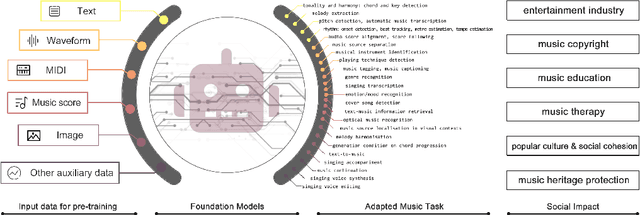
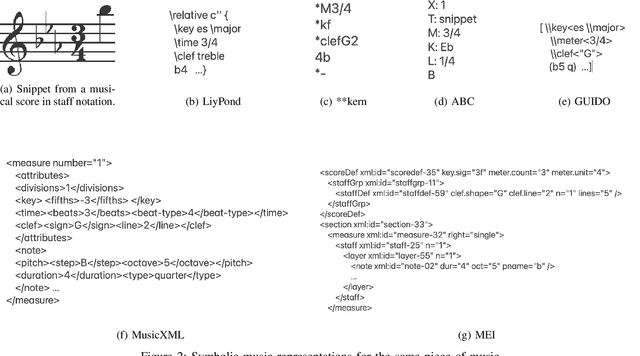
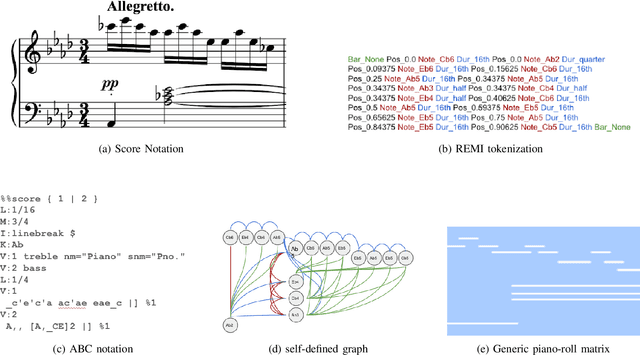
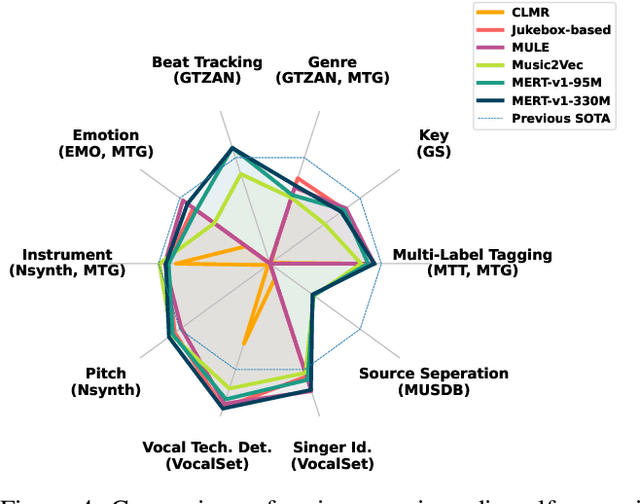
Abstract:In recent years, foundation models (FMs) such as large language models (LLMs) and latent diffusion models (LDMs) have profoundly impacted diverse sectors, including music. This comprehensive review examines state-of-the-art (SOTA) pre-trained models and foundation models in music, spanning from representation learning, generative learning and multimodal learning. We first contextualise the significance of music in various industries and trace the evolution of AI in music. By delineating the modalities targeted by foundation models, we discover many of the music representations are underexplored in FM development. Then, emphasis is placed on the lack of versatility of previous methods on diverse music applications, along with the potential of FMs in music understanding, generation and medical application. By comprehensively exploring the details of the model pre-training paradigm, architectural choices, tokenisation, finetuning methodologies and controllability, we emphasise the important topics that should have been well explored, like instruction tuning and in-context learning, scaling law and emergent ability, as well as long-sequence modelling etc. A dedicated section presents insights into music agents, accompanied by a thorough analysis of datasets and evaluations essential for pre-training and downstream tasks. Finally, by underscoring the vital importance of ethical considerations, we advocate that following research on FM for music should focus more on such issues as interpretability, transparency, human responsibility, and copyright issues. The paper offers insights into future challenges and trends on FMs for music, aiming to shape the trajectory of human-AI collaboration in the music realm.
Self-Train Before You Transcribe
Jun 17, 2024Abstract:When there is a mismatch between the training and test domains, current speech recognition systems show significant performance degradation. Self-training methods, such as noisy student teacher training, can help address this and enable the adaptation of models under such domain shifts. However, self-training typically requires a collection of unlabelled target domain data. For settings where this is not practical, we investigate the benefit of performing noisy student teacher training on recordings in the test set as a test-time adaptation approach. Similarly to the dynamic evaluation approach in language modelling, this enables the transfer of information across utterance boundaries and functions as a method of domain adaptation. A range of in-domain and out-of-domain datasets are used for experiments demonstrating large relative gains of up to 32.2%. Interestingly, our method showed larger gains than the typical self-training setup that utilises separate adaptation data.
Training Data Augmentation for Dysarthric Automatic Speech Recognition by Text-to-Dysarthric-Speech Synthesis
Jun 12, 2024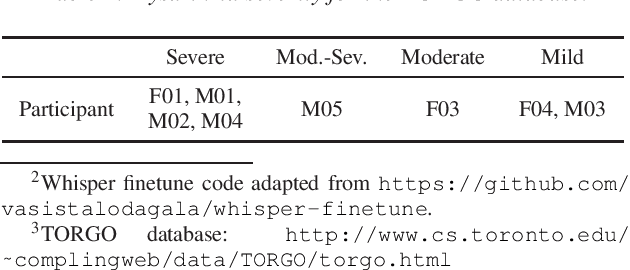
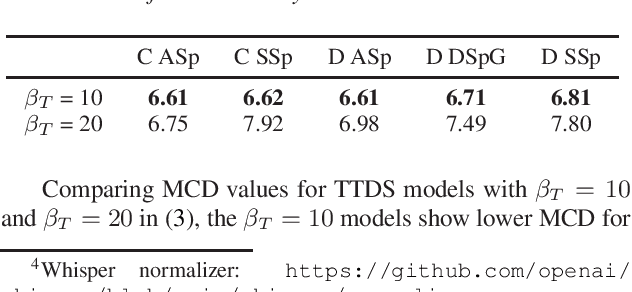


Abstract:Automatic speech recognition (ASR) research has achieved impressive performance in recent years and has significant potential for enabling access for people with dysarthria (PwD) in augmentative and alternative communication (AAC) and home environment systems. However, progress in dysarthric ASR (DASR) has been limited by high variability in dysarthric speech and limited public availability of dysarthric training data. This paper demonstrates that data augmentation using text-to-dysarthic-speech (TTDS) synthesis for finetuning large ASR models is effective for DASR. Specifically, diffusion-based text-to-speech (TTS) models can produce speech samples similar to dysarthric speech that can be used as additional training data for fine-tuning ASR foundation models, in this case Whisper. Results show improved synthesis metrics and ASR performance for the proposed multi-speaker diffusion-based TTDS data augmentation for ASR fine-tuning compared to current DASR baselines.
Non-Intrusive Speech Intelligibility Prediction for Hearing-Impaired Users using Intermediate ASR Features and Human Memory Models
Jan 24, 2024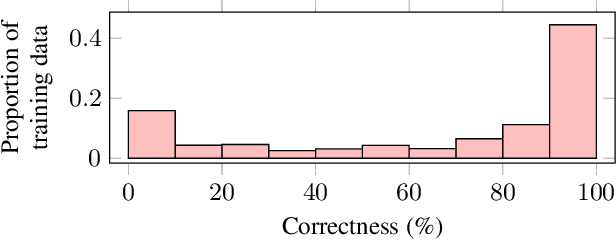

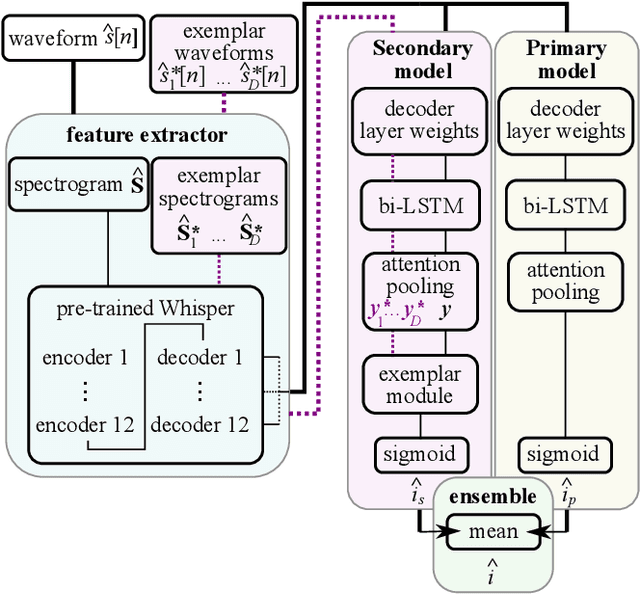
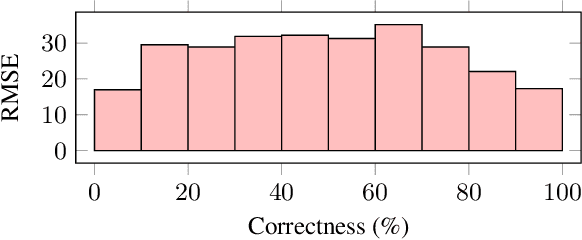
Abstract:Neural networks have been successfully used for non-intrusive speech intelligibility prediction. Recently, the use of feature representations sourced from intermediate layers of pre-trained self-supervised and weakly-supervised models has been found to be particularly useful for this task. This work combines the use of Whisper ASR decoder layer representations as neural network input features with an exemplar-based, psychologically motivated model of human memory to predict human intelligibility ratings for hearing-aid users. Substantial performance improvement over an established intrusive HASPI baseline system is found, including on enhancement systems and listeners unseen in the training data, with a root mean squared error of 25.3 compared with the baseline of 28.7.
How Much Context Does My Attention-Based ASR System Need?
Oct 24, 2023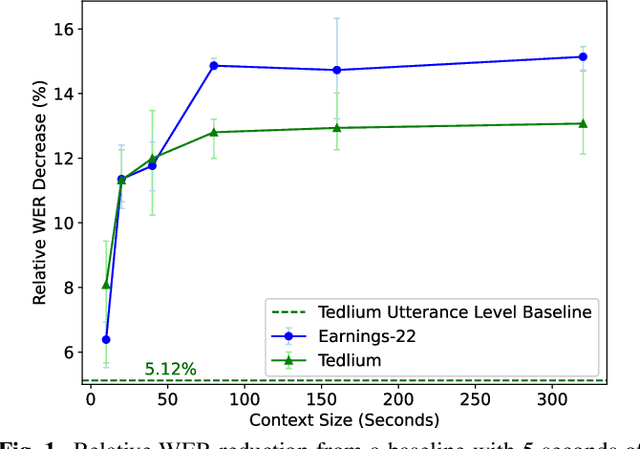

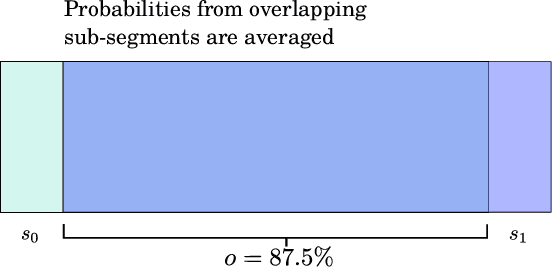

Abstract:For the task of speech recognition, the use of more than 30 seconds of acoustic context during training is uncommon, and under-investigated in literature. In this work, we examine the effect of scaling the sequence length used to train/evaluate (dense-attention based) acoustic and language models on speech recognition performance. For these experiments a dataset of roughly 100,000 pseudo-labelled Spotify podcasts is used, with context lengths of 5 seconds to 1 hour being explored. Zero-shot evaluations on long-format datasets Earnings-22 and Tedlium demonstrate a benefit from training with around 80 seconds of acoustic context, showing up to a 14.9% relative improvement from a limited context baseline. Furthermore, we perform a system combination with long-context transformer language models via beam search for a fully long-context ASR system, with results that are competitive with the current state-of-the-art.
Energy-Based Models For Speech Synthesis
Oct 19, 2023Abstract:Recently there has been a lot of interest in non-autoregressive (non-AR) models for speech synthesis, such as FastSpeech 2 and diffusion models. Unlike AR models, these models do not have autoregressive dependencies among outputs which makes inference efficient. This paper expands the range of available non-AR models with another member called energy-based models (EBMs). The paper describes how noise contrastive estimation, which relies on the comparison between positive and negative samples, can be used to train EBMs. It proposes a number of strategies for generating effective negative samples, including using high-performing AR models. It also describes how sampling from EBMs can be performed using Langevin Markov Chain Monte-Carlo (MCMC). The use of Langevin MCMC enables to draw connections between EBMs and currently popular diffusion models. Experiments on LJSpeech dataset show that the proposed approach offers improvements over Tacotron 2.
 Add to Chrome
Add to Chrome Add to Firefox
Add to Firefox Add to Edge
Add to Edge